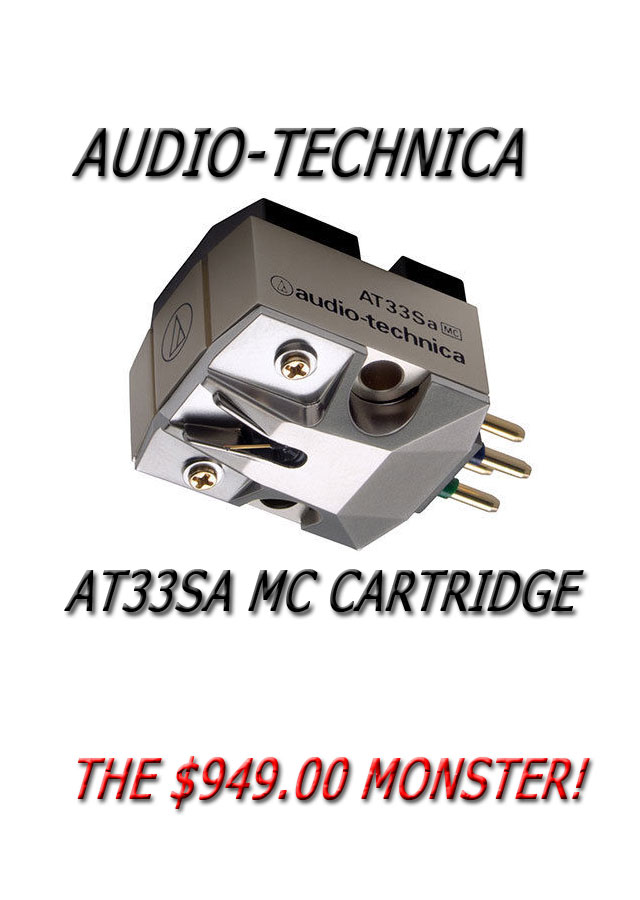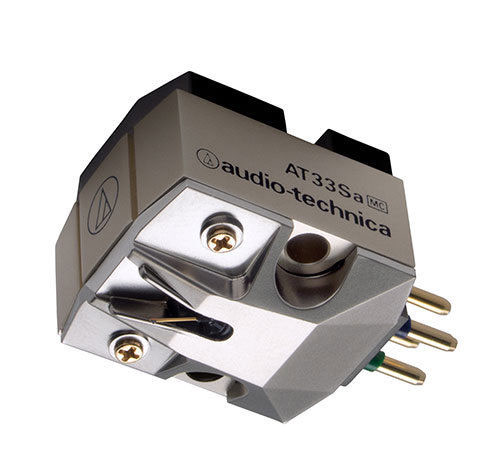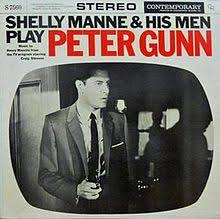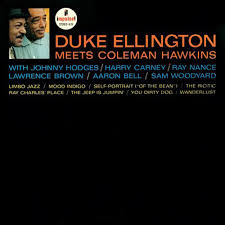Audio-Technica AT33Sa MC Phono Cartridge

I’m Not Dead Yet
 I’ve spent a great deal of time over the past year waxing on about the vintage Rek-O-Kut T12h idler drive turntable that I rebuilt for monaural playback. So much so that one might have gotten the impression that it’s my primary table. It’s not. A thirty-year-old Sota Star-Sapphire that I bought about a decade ago from a gentleman at MIT holds that slot. It’s got the renowned Sota vacuum system and sapphire bearing, as well as the four-point suspended platter and arm-board. It’s about ready to go back to the factory for some maintenance and additional updates, but it still runs great and it’s still a very fine sounding turntable. When I got it the Sota was outfitted with an AudioQuest PT-6 tonearm – a re-branded Jelco – and about three years ago I upgraded to its current arm, a Jelco 750-DB. Every upgrade in arm or cartridge has been audible using the same turntable as a platform, suggesting that the table itself is just fine.
I’ve spent a great deal of time over the past year waxing on about the vintage Rek-O-Kut T12h idler drive turntable that I rebuilt for monaural playback. So much so that one might have gotten the impression that it’s my primary table. It’s not. A thirty-year-old Sota Star-Sapphire that I bought about a decade ago from a gentleman at MIT holds that slot. It’s got the renowned Sota vacuum system and sapphire bearing, as well as the four-point suspended platter and arm-board. It’s about ready to go back to the factory for some maintenance and additional updates, but it still runs great and it’s still a very fine sounding turntable. When I got it the Sota was outfitted with an AudioQuest PT-6 tonearm – a re-branded Jelco – and about three years ago I upgraded to its current arm, a Jelco 750-DB. Every upgrade in arm or cartridge has been audible using the same turntable as a platform, suggesting that the table itself is just fine.
Ten years is a long time to keep any hi-fi component around, especially one that’s now been spinning for a total of three decades. But the Sota is a very robust machine and the basic original design was a good one. The Star Sapphire of the early 1990s has been modified and improved to the current equivalent vacuum model – the Nova – but the essentials are still the same: a lead-damped fifteen-pound platter with a sandwiched acrylic and aluminum arm board, sprung to resist all manner of footfalls, passing subway trains, and naturally occurring seismic activity. Sota has made some significant improvements in motor and bearing mechanics over the years, but visually, other than a few fewer buttons on the new ones and some scars on the case of my old one, you’d be hard pressed to tell the difference between the table in my system and one just coming off the line.
 I have from time-to-time considered replacing my Sota with something new and more theoretically state-of-the-art, but the long and short of it is, I’d have to spend a hell of a lot of money to get a better turntable and I haven’t been able to come to a cost-benefit equation that’s convinced me to pull the trigger, especially considering I paid peanuts for the one I have before the resurgence of vinyl over the past few years. Yes, my Star-Sapphire is old but it’s still a great turntable. Upgrading to current specifications will cost a fraction of buying a new one and as a bonus you can call the company in Wisconsin and get the owners on the phone. To replace it with something supposedly “better” would easily cross into five-figure territory and almost certainly would not include the vacuum feature.
I have from time-to-time considered replacing my Sota with something new and more theoretically state-of-the-art, but the long and short of it is, I’d have to spend a hell of a lot of money to get a better turntable and I haven’t been able to come to a cost-benefit equation that’s convinced me to pull the trigger, especially considering I paid peanuts for the one I have before the resurgence of vinyl over the past few years. Yes, my Star-Sapphire is old but it’s still a great turntable. Upgrading to current specifications will cost a fraction of buying a new one and as a bonus you can call the company in Wisconsin and get the owners on the phone. To replace it with something supposedly “better” would easily cross into five-figure territory and almost certainly would not include the vacuum feature.
I stand by a mantra first uttered by a good friend many years ago: You can have my Sota when I’m dead…maybe.
Knuckle Draggers and Sophisticates – Cartridge Evolution
When I purchased my Star-Sapphire it was to replace a Thorens TD-160 Super with a Grace 707 arm and a Shure M97Xe moving magnet cartridge (I’m still kicking myself for selling the TD-160). In addition to the Sota, the plan included upgrading my phono stage and diving into the wide, wonderful world of moving coil cartridges, although at the time I didn’t know very much about either. The fellow I bought the table from told me that he’d been using an Audio-Technica OC/9 cartridge and had good things to say about it. I checked it out, finding that it was both well reviewed and affordable, so I followed his advice, acquiring an OC/9-II of my own, along with a modest ProJect Tube-Box phono stage. That combination became my basic vinyl rig for the better part of eight years or so.

More recently I went through an experimental phase with a bunch of step-up transformers and phono stages – both stand alone and the one built into my preamp – finally settling on a substantial upgrade for stereo moving coil listening, the Lyric Audio PS-10 phono stage. But over all those years and equipment evaluations there’ve really only been two cartridges permanently installed on the Sota: The Audio-Technica OC/9-II, which I accidentally and spectacularly destroyed about eighteen months ago, and the current production OC/9-III (3), and I’ve been quite happy with both. In my review of the OC/9-III last year I called it a moving coil for the masses, offering a good taste of what a great moving coil can do for a price almost anyone could afford. It’s my kind of component.
But Audio-Technica has a lot of cartridges above and below the OC/9-III in their lineup, with prices that start at $29 and go all the way up to $5,000 for the very well received AT-ART 1000. Although it’s a seemingly lateral move, I was particularly interested in the AT33Sa, largely because I was interested in hearing its Shibata stylus, so I asked for a review sample.
The Audio-Technica AT33Sa
The AT33Sa moving coil phono cartridge has essentially identical specifications to the OC/9-III in almost every measurement: 15 – 50,000 Hz frequency response (dog-whistle territory); 30 dBs of channel separation, recommended loading greater than 100 ohms, output of 0.4 mV, a sold boron cantilever, and recommended tracking force of 2 grams. On the spec sheet, at least, the only major difference between the two cartridges is the stylus profile and the shape of the body. The OC/9 has a tapered body and a Line Contact stylus while the AT33Sa is brick-shaped and uses a Shibata diamond. Even the prices of the two cartridges are within spitting distance of each other. The Audio-Technica website lists the OC/9-III for $999, while the AT33Sa undercuts it slightly at $949.
.jpg?KeepThis=true&TB_iframe=true&height=430&width=700)

In the metal, the AT33Sa is – as I mentioned – brick shaped and gold. It’s a standard half-inch mount, but the holes are not threaded necessitating the use of old-fashioned tiny nuts to hold it in place, something that shouldn’t exist anymore in 2018. I would not want to have to install this cartridge on an arm without a detachable headshell.
Flipping the cartridge onto its back reveals the cantilever and stylus assembly, which is exceptionally delicate looking and makes the folded metal cantilever on my Miyajima Spirit Mono look like a trailer hitch. I was initially incredulous that something so delicate could support its own two-gram tracking force, but it does.
The AT33Sa was not an especially easy cartridge to setup, first because of the omission of threaded holes in the body (alas), but primarily because its large body made it difficult to see the stylus as I aligned it on a Dr. Fliekert’s protractor. Its brick shape and somewhat setback cantilever necessitated looking head-on directly into the space between the body and point of contact instead of being able to look down at the needle sitting over the hash marks. I added more LEDs than usual to my setup tools, eventually getting it setup properly with the help of an additional headlamp, but it was tricky. Also, I was concerned that my fat fingers would indelicately snap the cantilever right off as I shifted the cartridge in the headshell, although that would have obviously been a case of user error.
Setup, of course, is an infrequent process. After it was aligned properly – and re-checked a few weeks later and periodically thereafter – there were no issues with slippage or anything else that required re-adjustment. It was smooth sailing from there out.
A Tale of Two Coils
Common sense would suggest that two cartridges with such similar specifications and prices from the same manufacturer would have a lot in common sonically, but that proved to not necessarily be the case. Both are clean and detailed without being especially warm, which seems to be an AT house trait, but beyond that there are some rather pronounced sonic differences between these two pickups. For the most part, on my table and to my listening preferences, favor fell upon the Shibata equipped AT33Sa. Although they’re priced similarly, the AT33Sa was a step up in overall refinement, frequency extension and detail over the OC/9-III, though there is one area where the OC/9 may retain an advantage, which I’ll come back to.
The AT33Sa in Action
 The AT33Sa took a while to fully open up, playing regularly for a good six weeks before starting this review in earnest. AT recommends loading the AT33Sa at greater than 100 ohms. I experimented with a few settings on my phono-stage but felt that exactly 100 provided the best balance across the frequency range with my gear. It was buttery smooth right out of the box, but initially it also sounded small, a bit soft and bereft of dynamics. Over time the soundstage expanded, developing a more muscular presentation. When the frequency extremes had filled out, particularly in the bass, I concluded that the cartridge was fully broken in.
The AT33Sa took a while to fully open up, playing regularly for a good six weeks before starting this review in earnest. AT recommends loading the AT33Sa at greater than 100 ohms. I experimented with a few settings on my phono-stage but felt that exactly 100 provided the best balance across the frequency range with my gear. It was buttery smooth right out of the box, but initially it also sounded small, a bit soft and bereft of dynamics. Over time the soundstage expanded, developing a more muscular presentation. When the frequency extremes had filled out, particularly in the bass, I concluded that the cartridge was fully broken in.
Starting with the basics, the AT33Sa is a quieter cartridge in the groove. The Shibata stylus is the likely benefactor here; something this profile is renowned for. Not that the OC/9 is noisy, per se – it’s not especially – but, particularly on older vinyl, the AT33Sa just does a better job of minimizing background noise, and less noise equals more music.
In general, the AT33Sa is a higher resolution device, producing sonic images with less feathering at the edges. Instruments are more distinct in space and as a result layering and soundstage depth is enhanced.
Treble, reflecting the cartridge’s specifications, has exceptional extension, and perhaps more importantly, is very clean. The cartridge largely banished any high-treble hardness, glare and distortions on familiar records, and did so while preserving all the details, air and reverberations that arrive in that region of frequency response. The AT33Sa is a real smoothie here, and in a very satisfying, sonically complete way. I didn’t hear anything that could be described as artificial buffing due to roll-off, and I never felt like there were any omissions.
Bass also delivered improved response. Simply put, this cartridge went deeper with more power and authority. Whether listening to Ray Brown or Parliament, the low end was more completely fleshed out, dimensional and solid than I’m accustomed to. Moreover, this enhanced bass was not an artificial bump. It was smooth, natural and contiguous all the way down.
The midrange – the heart of the music – also exhibited liquidity and resolution woven into whole cloth with the treble and bass. The AT33Sa was notably consistent, exhibiting no discernable favoritism. There was nothing about the midrange, or any other area of the spectrum that attracted any unfavorable attention to itself by standing out against the rest.
But it was the midrange that also offered the greatest contrast in overall character between the AT33Sa and the OC/9. The midrange on the OC/9 is a little more forward and perhaps a bit hairy chested. I wouldn’t say it’s comparatively coarse – it too is a refined cartridge – but in my system the OC/9’s mids seemed to have a little more texture and grip on the music, which some listeners may prefer. Also, in back-to-back listening the OC/9 audibly placed the midrange slightly in front of the bass and treble. By comparison the AT33Sa revealed little if any bias, had greater extension at the extremes, and was remarkably linear from top to bottom. I preferred the AT33Sa, as an improvement to my taste in my system, but this is certainly not an indictment of the OC/9.
Importantly, there are no wrong answers here. I’ve happily used OC-9 cartridges for a decade and the current version remains an excellent cartridge. Choose the qualities that are important to you. You’re not going to go wrong either way.
Listening
 An old favorite is Shelly Manne and His Men Play Peter Gunn (Contemporary/Stereo Records S-7025, 1959). An early Roy DuNann stereo recording, Play Peter Gunn sounds like a group of musicians playing together in one space. There is some hard-positioning of the horns right in front of the speakers, but the vibes, drums, piano and bass are all arranged naturally across the stage. More importantly, all of the instruments sound thoroughly realistic – including the piano. I’ve listened to this very well recorded album in various formats a hundred times over the years, but the AT33Sa enhanced some of the details. Monty Budwig’s bass is more deeply recessed into the soundstage, while Manne’s ride cymbal rings in space with more pinpoint accuracy. On “The Floater” you can hear DuNann audibly adjust the mics in real time on Russ Freeman’s piano to expand its placement in the soundstage during the solo. Side two opens with “Fallout” featuring Victor Feldman playing the marimba. The woody midrange tones are more thoroughly natural sounding, and a nice, underutilized alternative to the vibraphone. If anything, the AT33Sa revealed the recording to be a little dryer and documentary than I’d heard it before, but still exceptional.
An old favorite is Shelly Manne and His Men Play Peter Gunn (Contemporary/Stereo Records S-7025, 1959). An early Roy DuNann stereo recording, Play Peter Gunn sounds like a group of musicians playing together in one space. There is some hard-positioning of the horns right in front of the speakers, but the vibes, drums, piano and bass are all arranged naturally across the stage. More importantly, all of the instruments sound thoroughly realistic – including the piano. I’ve listened to this very well recorded album in various formats a hundred times over the years, but the AT33Sa enhanced some of the details. Monty Budwig’s bass is more deeply recessed into the soundstage, while Manne’s ride cymbal rings in space with more pinpoint accuracy. On “The Floater” you can hear DuNann audibly adjust the mics in real time on Russ Freeman’s piano to expand its placement in the soundstage during the solo. Side two opens with “Fallout” featuring Victor Feldman playing the marimba. The woody midrange tones are more thoroughly natural sounding, and a nice, underutilized alternative to the vibraphone. If anything, the AT33Sa revealed the recording to be a little dryer and documentary than I’d heard it before, but still exceptional.
 Another household favorite is Duke Ellington Meets Coleman Hawkins (Impulse/Analogue Productions AS-26 1963). This is one of the great Rudy Van Gelder recordings from his studio in Englewood Cliffs, NJ, reproduced here on an Analog Productions 45 rpm pressing. This version of “Mood Indigo” is one of my favorite tracks in jazz, bar none. Hawkins’ solo – which lasts for effectively the entire song, ala’ his original 1939 improvisation on “Body and Soul” – is beautifully constructed from start to finish. His tenor is full-bodied, with a softer mellifluous tone than was in vogue with Coltrane or Rollins during the same period. If his horn harked back to an earlier era, his playing is absolutely on point, demonstrating Hawk’s first-rate skills as an improviser with an iron grip on maneuvering within the melody. The AT33Sa delivered all of it with exceptional clarity and realism. The instruments in the soundstage are almost larger than life-sized, with Hawk forward to one side in the stage and Duke deep in the center. The massed orchestra has saturated color and density, and the bass of Aaron Bell, placed directly in front Duke’s piano in the center, is plump and physical. This is clearly an RVG recording – the piano, as always, is the dead giveaway – but it’s an exceptional RVG recording, and in my system, it’s never sounded better than it does with this cartridge.
Another household favorite is Duke Ellington Meets Coleman Hawkins (Impulse/Analogue Productions AS-26 1963). This is one of the great Rudy Van Gelder recordings from his studio in Englewood Cliffs, NJ, reproduced here on an Analog Productions 45 rpm pressing. This version of “Mood Indigo” is one of my favorite tracks in jazz, bar none. Hawkins’ solo – which lasts for effectively the entire song, ala’ his original 1939 improvisation on “Body and Soul” – is beautifully constructed from start to finish. His tenor is full-bodied, with a softer mellifluous tone than was in vogue with Coltrane or Rollins during the same period. If his horn harked back to an earlier era, his playing is absolutely on point, demonstrating Hawk’s first-rate skills as an improviser with an iron grip on maneuvering within the melody. The AT33Sa delivered all of it with exceptional clarity and realism. The instruments in the soundstage are almost larger than life-sized, with Hawk forward to one side in the stage and Duke deep in the center. The massed orchestra has saturated color and density, and the bass of Aaron Bell, placed directly in front Duke’s piano in the center, is plump and physical. This is clearly an RVG recording – the piano, as always, is the dead giveaway – but it’s an exceptional RVG recording, and in my system, it’s never sounded better than it does with this cartridge.
And Now For Something Completely Different
I can’t deny it. As I’ve gotten older I’ve become a bit musically hidebound, eschewing virtually all of the pop music of my youth in favor of the jazz that makes up the bulk of my record collection, and increasingly – over the last couple of years – classical.
But every now and again as I peruse the dusty bins at the local shops, I hit a record that was so personally influential when I was, say, fifteen years old that I simply can’t leave it behind. These records don’t always translate well to my forty-nine-year-old self, but that doesn’t mean it isn’t occasionally entertaining to revisit them.
Remember when having thirteen channels of shit on the TV to choose from seemed like a lot?
 Yes, a few days ago, stuffed into a bag with a few jazz records, was a nice-looking copy of Pink Floyd’s The Wall, which I’m certain I’ve not listened to all the way through since 1987 or so. When I was in high school this double LP was everywhere. We wore out vinyl copies, then crowded around to marvel at the first CD players, smitten with ‘perfect sound forever’. In fact, now that I think of it, The Wall may well have been the first album I ever heard on CD, or darned close to it. At the time, sobriety was not a desirable part of the listening experience. Thirty-plus years later – sans the grass – The Wall is a mixed bag.
Yes, a few days ago, stuffed into a bag with a few jazz records, was a nice-looking copy of Pink Floyd’s The Wall, which I’m certain I’ve not listened to all the way through since 1987 or so. When I was in high school this double LP was everywhere. We wore out vinyl copies, then crowded around to marvel at the first CD players, smitten with ‘perfect sound forever’. In fact, now that I think of it, The Wall may well have been the first album I ever heard on CD, or darned close to it. At the time, sobriety was not a desirable part of the listening experience. Thirty-plus years later – sans the grass – The Wall is a mixed bag.
Having long ago gotten over any attraction to musical angst, the lyrics seem overwrought, and there are certain motifs that become repetitiously tiresome, but it’s still a pretty good listen. It’s not as perfectly and concisely constructed as Dark Side of The Moon, but The Wall is not boring by any means, although fascist imagery and Nazi pep rallies were easier to toss off as irrelevant in the days before our current political climate. The shear scale of it has more in common with a Broadway spectacular than a performance by a rock & roll band, especially if you think of marching hammers as some twisted equivalent of the Rockettes.
As a recording The Wall is uneven, or at least the copy I have is. Some tracks sound terrific with genuine weight and really tight, well-defined slam. Other parts – massed voices and shouting – can sound a bit flat and simultaneously hard edged. Editing down the arrangements in some of those passages would have allowed better definition and clarity, and simplification probably would have improved the music overall, but of course, The Wall was a pinnacle of prog-rock excess. Restraint was never part of the plan, so that’s all wishful thinking on my part.
Through its entirety the AT33Sa delivered the goods, at least where there were goods to be delivered. The parts that are really well recorded sound exceptionally good, particularly solo male voices and acoustic guitars: natural, realistic, and totally present. A trio of consecutive tracks reveals the somewhat schizophrenic engineering. “Nobody Home” stands out with its simple vocal/piano right in the middle, captured very naturally. On the other hand, the massed voices singing ‘Bring the Boys Back Home’ during “Vera Lynn” are muddy, indistinct, and a little distorted. Whipsawing to the very next track, “Comfortably Numb,” is clean and precise again. It’s a little frustrating to listen to. The grand finale – “The Trial” – is a hot mess, though that has as much to do with Roger Waters’ kitchen sink self-indulgence, yielding an operatic conclusion that would have embarrassed Wagner. Still, it’s an interesting descent into secondary-school nostalgia, even if it doesn’t seem as remotely profound without the mind-altering accouterments.
The AT33Sa did a really good job of reproducing The Wall, nailing the finer parts, the warts, and all the in-betweens with transparent honesty. You can’t ask for much more than that from a cartridge.
Conclusions
I was reading a turntable review recently where the author performed his evaluation using four cartridges with a combined value of close to $50,000 – considerably more money than I paid for my car. I’m never going to play in that arena, and chances are – unless you hit the lottery – neither are you.
Fortunately, for the rest of us there are still great hi-fi products that offer exceptional performance at attainable prices. Most lay people would still consider $949 to be an awful lot of money for four tiny magnets and some bits of copper wire (my dad, for example), but by todays lofty standards it’s within the affordable range of the price spectrum.
More importantly, with the law of diminishing returns applying to phono cartridges the same way it does to any other component, the AT33Sa represents something of a bargain. I recently had the opportunity to hear a bunch of expensive moving coils back-to-back at a regional audio show. I was careful to keep my impressions of the AT33Sa in mind as I went, making mental comparisons along the way. The Audio-Technica stacked up better than you might expect against some very pricy competition. No, the AT33Sa didn’t have the sheer dynamism and raw power of something like a Lyra Atlas, but it doesn’t sound like it costs less than 1/10th the price either, which it does. More tellingly, there were exhibitors at the show confidently using Audio-Technica cartridges in their demonstration turntables and they sounded terrific, which says a lot about how good these cartridges are.
Forgetting about price considerations, the AT33sa is a darned good phono cartridge on its own terms. It has excellent resolution, scale, and that elusive believability that can transform listening to a record into listening to a musical performance. It revealed new qualities in some old familiar recordings, showed flaws in others, and made great pressings sound even better. It was unfailingly engaging.
There are no excuses or caveats necessary when describing the performance of the AT33Sa. This is a great cartridge, period. You could spend ten times the price, but I wouldn’t bet that you’ll get ten times the performance. Audio-Technica builds some great pickups and the AT33Sa is definitely one of them. Most highly recommended!


greg simmons
Specifications
Price: $949.00 USA
Type: Moving Coil Phono Cartridge
Stylus: Shibata Stylus
Cantilever: Tapered Boron Cantilever
Magnet: Neodymium
Copper Wire: Ohno Continuous Casting
Body: Aluminum Alloy
Frequency Response: 15-50,000 Hz
Channel Separation: 30dB (kHz)
Vertical Tracking Force: 1.8 – 2.0g (2.0g standard)
Recommended Load Impedance: Greater than 100 Ohms
Output: 0.4mV (at 1kHz, 5cm/sec)
Chanel Balance: 0.5dB (1 kZ)
Mount: ½ inch
Website: www.audio-technica.com
One thought on "Audio-Technica AT33Sa MC Phono Cartridge"
Leave a Reply
Stereo Times Masthead
Publisher/Founder
Clement Perry
Editor
Dave Thomas
Senior Editors
Frank Alles, Mike Girardi, Russell Lichter, Terry London, Moreno Mitchell, Paul Szabady, Bill Wells, Mike Wright, and Stephen Yan,
Current Contributors
David Abramson, Tim Barrall, Dave Allison, Ron Cook, Lewis Dardick, John Hoffman, Dan Secula, Don Shaulis, Greg Simmons, Eric Teh, Greg Voth, Richard Willie, Ed Van Winkle, Rob Dockery, Richard Doron, and Daveed Turek
Site Management Clement Perry
Ad Designer: Martin Perry






Hi Greg, thanks for your thoughtful and comprehensive remarks about the AT33Sa. I have been running mine for 2 years now, and each LP I play (many of them going back 50 years) sounds new to me. My thoughts: people always talk about “detail” in phono reproduction, and I believe I understand what they mean, but what the AT33Sa does for me that no other cartridge has managed to do as well, is reproduce the human “ess” sound (and some cymbal sounds) accurately without turning them into an unbalanced, sloppy mess. Granted, I am new to moving coil cartridges, but the properly setup AT33Sa does better across my entire collection than any other cartridge I have used. Thanks for listening!
Doug